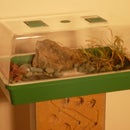Introduction: How to Maintain Your Multi-tool.
Left your favourite Multi-tool outside? Rusted?
Or just not opening smoothly...
Here's how to fix and maintain it.
Your Multi-tool may not be similar... but the same guide can be followed..
What you will need:-
- 1200/800g Wet-n-Dry abrasive paper
- Lubricant preferably teflon based
- Clean dry cloth
- Small container
Let's begin!
Step 1: Taking Your MT Apart-
When taking your MT apart, especially for the first time, it is important to remember and note which pieces go where...
Believe me, if you get them messed up your going to be there for a while sorting the mess out.
I prefer to take an A4 piece of paper, and line the parts out in order...
This allows us to simply "stack", the parts back into the chassis of the unit..
Begin by locating the fixing mechanism's, which retain the implements..
On my model I have four small bolts...
Some models have a swing arm locking mech..
Locate it and remove the locking system..
Step 2: Removing Implement Stacks
Now we will remove the implement stacks..
Before doing so have a look at how they are stacked, how the finger grips are positioned etc. This will be important when re-assembling the unit...
Take care not to loose the spacer washers if used.
Take the stack out in one piece..
Then line the implements out in the order of the stack..
Write numbers on the paper for reference if needed..
Once we have everying separated, it should be easy to see rust, wear and tear etc...
Step 3: Removing Rust, Grime and Burrs
Now to remove rust and matter not wanted in the unit...
Particular attention, needs to be paid towards the rust...
My tool is stainless steel of a reasonable grade... It still rusted due to a leaky basement..
If ANY rust or tarnish, from the rust is left, it is likely to come back very quickly..
So remove it ALL!
Get some Wet-n-Dry abrasive paper...
Lots of rust- 800g but be carefull not to scratch the stainless steel..
Just light circles until the rust has lots its "thickness".
Finish with 1200g then as follow's
No dense rust/tarnish- 1200g but get too pieces and rub them together to
remove some of the grit... It will turn slightly white... Then small very light swirls till you return it to the stainless.. The closer you get to the bright stainless the smaller the swirls.... We do not want to scratch the finished surface..
Step 4: Lubricating
Now we need to apply some lubrication. In order for our Multi-tool to function smoothly and not attract dirt into the mechanism's causing it to sieze, we need a barrier...
Something I tried a long time ago, was the teflon based lube's. These worked but it was nothing spectacluar... What seems to be fantastic are bike chain lubricant's. Not the cheap stuff, something decent like Rocknroll... Just had some handy one day since I bike alot...
What ever you use I suggest it's teflon based and NOT an oil or grease... These will attract grit and grime from your hands... Remember we often have sweaty salty hands whilst we work.. Not good for stainless steel... Remember it is just "stainLESS" not "stainproof"..
Fill a small container with it and dip the the implements into the lube...
Remove excess with a clean cloth...
Make sure there is only a thin layer remaining... If you are using a teflon based lube, it will leave a white film....Don't worry about this, it will wear off exterior surface area's later.
Give the pliers a good soaking and operate the jaws to let the lube penetrate..
Remove and dry completley..
Step 5: Inserting Cartridge
After each piece, has had a total covering of lube and been dryed it's time to assemble the cartridge to go back into the chassis..
This is where it's going to pay off, that we labelled and ordered the pieces...
Stack the pack of implements back together and insert back into chassis...
If you are un-able to stack it back in one piece, try using the locking bolt/pin and stack them back in one at a time...
Once back inside the unit. Re-tighten the locking mechinism, but not completley...
We need to dip the end of the cartridge, one more time as an assembled unit..
Once the end of the cartridge is completely saturated, work the implements back and forth till all the lube has penetrated and left a thin layer inbetween the implements....
Dry end of cartridge completley...
Step 6: Attaching the Head/pliers
The next step is connect the head, which in my case is another two of my bolts... Your head maybe different but re-attach as you took off.
Make sure everything fits inline and is not skewed in the closed case.
Re-tighten all bolt's completley. Your will notice that the pivoting joint now moves more freely, requiring slightly more tightening of the locking mechanism. This is normal because you have removed the grit and grime...
If you have a reasonable Multi-tool that's all the plier head requires to function correctly.
Step 7: Polish and Your DONE!
To get it nice and shiney, we should probably give it a bit of a polish with some stainless steel polishing compund preferably but standard kitchen polish should do...
Ensure not to get any on the cartridge swivel point....
And your done!!
I would also now put the edges, back onto the blades to finish it of so it's nice and sharp too...
But I won't cover that here there's plenty of ibles on that!
Hope this is helpful..! :)
Participated in the
The Instructables Book Contest













